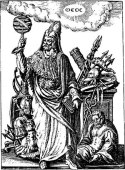Ancient Poet
Literary Form
 A literary form in the Bible is essentially the same as in any other kind of literature in a relevant language. Examples used in the Bible include Poetry such as Psalms, Proverbs, Song of Solomon and Job. Hebrew poetry also has a number of interesting characteristics such as various types of parallelism where ideas which are similar are repeated or also opposites are put into contrast.
Jesus, as the master teacher also used a number of literary forms and devices in
this work, which those who wrote down His words undoubtedly endeavored to
preserve. Some of these, which are lost in translation, apparently included
pnemonic devices to aid memory and note-taking Read more:
Wiki Answers
A literary form in the Bible is essentially the same as in any other kind of literature in a relevant language. Examples used in the Bible include Poetry such as Psalms, Proverbs, Song of Solomon and Job. Hebrew poetry also has a number of interesting characteristics such as various types of parallelism where ideas which are similar are repeated or also opposites are put into contrast.
Jesus, as the master teacher also used a number of literary forms and devices in
this work, which those who wrote down His words undoubtedly endeavored to
preserve. Some of these, which are lost in translation, apparently included
pnemonic devices to aid memory and note-taking Read more:
Wiki Answers
Poetry
Poetry is a rhythmic expression of words. It comes in many forms and can be found throughout each of the standard works. In the scriptures, however, poetry is not set in poetic format and is, therefore, not always easy to recognize. “A soft answer turneth away wrath: but grievous words stir up anger” ( Proverbs 15:1 ) might not seem poetic to the reader, but it is a form of poetry, called parallelism. There are a number of forms of poetry found in the scriptures, but the most common form is parallelism.
Lens of the Soul
The mystic interprets the world through a different lens than is present in ordinary experience, which can prove to be a significant obstacle to those who research mystical teachings and paths. Much like poetry, the words of mystics are often idiosyncratic and esoteric, can seem confusing and opaque, simultaneously over-simplified and full of subtle meanings hidden from the unenlightened. To the mystic, however, they are pragmatic statements, without subtext or weight; simple obvious truths of experience.
Gateway to Mystery
It has been said, to pursue a purely intellectual understanding of God is like trying to see with your ears. That which is without color or form, unlimited and unfathomable, beyond imagination, without beginning or end, is impossible to conceive with the mind. When it comes to knowing God, the mind is blind and will always be. But there is a way to intuit with the inner self and recognize with the heart. This is the message of the mystic poets, who see the relationship between a seeker and God as the same as between a lover and their Beloved. They emphasize the importance of consistent remembrance, treating all with respect, and a simple faith. Their love of God awakens in the heart a yearning to rise up and touch the ocean of Oneness, to be consumed in the transcendental fire, to die in Love and be reborn anew. Source: Mystic Poets
in the sun / in the sun I feel as one / all in all is all we are / all in all is all we are / all in all is all we are
The All
 The
All (also called The One, The Absolute, The Great One, The Creator, The
Supreme Mind, The Supreme Good, The Father, and The Universal Mother) is
the Hermetic or panentheistic view of God, which is that everything that is, or
at least that can be experienced, collectively makes up The All. One Hermetic
maxim states, "While All is in The All, it is equally
true that The All is in All." The All can also seen to be androgynous,
possessing both masculine and feminine qualities in equal part.
The
All (also called The One, The Absolute, The Great One, The Creator, The
Supreme Mind, The Supreme Good, The Father, and The Universal Mother) is
the Hermetic or panentheistic view of God, which is that everything that is, or
at least that can be experienced, collectively makes up The All. One Hermetic
maxim states, "While All is in The All, it is equally
true that The All is in All." The All can also seen to be androgynous,
possessing both masculine and feminine qualities in equal part.
Hermetic
 The
second Hermetic Principle is basiclly defined in the following manner:
All is in the All and the All is in All.
"The Awesome Life Force" Page 467 published in 1984.
The
second Hermetic Principle is basiclly defined in the following manner:
All is in the All and the All is in All.
"The Awesome Life Force" Page 467 published in 1984.
"While All is in THE ALL, it is equally true that THE ALL is in ALL. To him who truly understands this truth hath come great knowledge."--The Kybalion by Three Initiates, [1912]








 Literary
forms used by spiritual teachers. Since, by definition, mystical
knowledge cannot be directly written down or spoken of (but must be
experienced), numerous literary forms that allude to such knowledge
- often with contradictions or even jokes - have developed.
Aphorisms and poetry include artistic efforts to crystallize some
particular description or aspect of the mystical experience in words
Literary
forms used by spiritual teachers. Since, by definition, mystical
knowledge cannot be directly written down or spoken of (but must be
experienced), numerous literary forms that allude to such knowledge
- often with contradictions or even jokes - have developed.
Aphorisms and poetry include artistic efforts to crystallize some
particular description or aspect of the mystical experience in words 
 In
the Gospels there are numerous examples of poetry in the sayings of
Jesus. This poetry of Jesus is to be found not in its rhyme but in its
rhythmic balance. The expression to describe this kind of poetry
is parallelismus membrorum, or parallelism in the members. Source:
In
the Gospels there are numerous examples of poetry in the sayings of
Jesus. This poetry of Jesus is to be found not in its rhyme but in its
rhythmic balance. The expression to describe this kind of poetry
is parallelismus membrorum, or parallelism in the members. Source: 